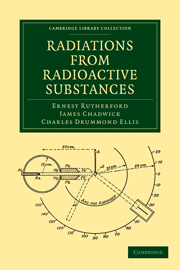Book contents
- Frontmatter
- Contents
- LIST OF PLATES
- Preface
- Chap. I Radioactive Transformations
- Chap. II The α Rays
- Chap. III Absorption of the α Rays
- Chap. IV Some Properties of the α Particle
- Chap. V Theories of Absorption of α Rays
- Chap. VI Secondary Effects produced by α Rays
- Chap. VII General Properties of the Radiations
- Chap. VIII The Scattering of α and β Particles
- Chap. IX The Collisions of α Particles with Light Atoms
- Chap. X The Artificial Disintegration of the Light Elements
- Chap. XI The Radioactive Nuclei
- Chap. XII β Ray and γ Ray Spectra
- Chap. XIII The Disintegration Electrons
- Chap. XIV The Passage of β Particles through Matter
- Chap. XV The Scattering and Absorption of γ Rays
- Chap. XVI Intensity Problems connected with the Emission of γ Rays
- Chap. XVII Atomic Nuclei
- Chap. XVIII Miscellaneous
- Appendix
- Subject Index
- Index of Names
- Plate section
Chap. XIV - The Passage of β Particles through Matter
Published online by Cambridge University Press: 07 September 2010
- Frontmatter
- Contents
- LIST OF PLATES
- Preface
- Chap. I Radioactive Transformations
- Chap. II The α Rays
- Chap. III Absorption of the α Rays
- Chap. IV Some Properties of the α Particle
- Chap. V Theories of Absorption of α Rays
- Chap. VI Secondary Effects produced by α Rays
- Chap. VII General Properties of the Radiations
- Chap. VIII The Scattering of α and β Particles
- Chap. IX The Collisions of α Particles with Light Atoms
- Chap. X The Artificial Disintegration of the Light Elements
- Chap. XI The Radioactive Nuclei
- Chap. XII β Ray and γ Ray Spectra
- Chap. XIII The Disintegration Electrons
- Chap. XIV The Passage of β Particles through Matter
- Chap. XV The Scattering and Absorption of γ Rays
- Chap. XVI Intensity Problems connected with the Emission of γ Rays
- Chap. XVII Atomic Nuclei
- Chap. XVIII Miscellaneous
- Appendix
- Subject Index
- Index of Names
- Plate section
Summary
§ 95. The study of the pa'ssage of β particles through matter encounters serious difficulties, both experimental and theoretical, which in most cases can be traced back to the ease with which these particles are scattered under the conditions in which experiments can be carried out. This scattering together with the rate of loss of energy constitute the two fundamental phenomena with which we are concerned, but unfortunately it is difficult to study the loss of energy without being seriously inconvenienced by the scattering.
In this respect β particles are far less amenable to investigation than α particles, which in the great majority of cases pursue straight paths until near the end of their range.
A convenient method of giving a general survey of the behaviour of β particles in traversing matter is to compare them with α particles. From this comparison we shall see how to differentiate between those experiments which can be easily analysed to give information about the mode of interaction of a β particle with an atom, and those experiments which, while valuable from a practical standpoint, yet prove on detailed consideration to be essentially complicated.
In the first place there is a considerable difference in penetrating power. While a few centimetres of air suffices to stop α particles, almost a hundred times as much is required to stop β particles. If in this preliminary comparison we neglect the slightly longer paths followed by the β particles due to their being scattered, we see that in a given distance the average number of collisions of a definite type with the atomic electrons will be the same for both sets of particles.
- Type
- Chapter
- Information
- Radiations from Radioactive Substances , pp. 411 - 450Publisher: Cambridge University PressPrint publication year: 2010First published in: 1930



